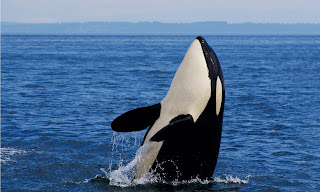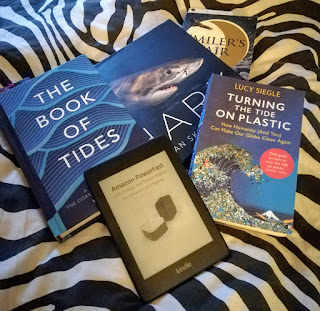Marine Creature of the Month SEPT 19
Marine Creature of the Month
Orcas aka Killer Whales
 |
| Photo from Defenders of Wildlife |
This was originally going to be a proper MCotM profile, but I have had bad brain this week. But rather than not post at all, I thought I'd give you the bullet point version - provided I can read my terrible hand written notes! I am also apparently going for a famous fish theme - Nemo last month, Free Willy this month - so if you know of a famous fish you'd like me to look into, just let me know!
Anyway, enough pre-amble, enjoy some facts about Orcas.
Kingdom: Animalia
Class: Mammalia
Conservation Status: Critically Endangered (CR)/Data Deficient (DD) - I will explain.
 |
| Photo from ThoughtCo |
- Orcas, while known as Killer Whales, are actually dolphins. They are even the largest species of dolphin with males growing between 6-8m (20-26ft) and females being slightly smaller at 5-7m (16-23ft).
- They live across the world, from tropical to cold waters. They prefer pelagic waters and are more commonly associated with arctic waters. But they are far spread, you can even see them off the coast of England at certain times of the year.
- There are three species of orca - Resident, Transient, and Offshore.
- Resident are the most commonly spotted orcas as they live near the coast. They also have very strong family bonds.
- Transient orcas have weaker family bonds and live in smaller groups. They also hunt marine mammals and are often referred to as Bigg's Killer Whales after the cetologist, Michael Bigg. (Cetologist is someone who studies marine mammals.)
- Offshore orcas live in the deeper, open waters - as the name would suggest. These often have scarred skin which suggests that their diets don't only consist of schooling fish but of bigger sea creatures too. It is not unheard of for orcas to hunt sharks! These orcas live in big groups.
- There are also four types of orca, and I'm honestly not sure why there are two different groupings for them. If anyone could tell me, I will love you forever. They are labeled Type A-D, with Type D being the least common. The different types are defined by their dorsal fin shape, their colouration, and the shape of their patches.
 |
| Photo from Freebird One |
- Orcas will genuinely eat anything. Fish, squid, seals, whales, sharks... if it swims close enough to its mouth, the orca will try to bite it.
- They are excellent hunters and, because they live in groups, their hunting methods are very sophisticated. If a seal is stranded on the ice, thinking itself safe, they will swim in formation to create a bow wave and knock it off. Dinner is served!
- They have even been known to hunt and kill sharks by biting their neck and holding them upside down. This puts the shark into a trance called Tonic Immobility, which renders them immobile. Most sharks cannot breathe in this state so the orca just has to wait for it to suffocate.
- Orcas are apex predators. This means that nothing preys upon them.
- They tend to live in matriarchal societies, meaning they are led by a female. The more familial species can live with up to four generations of orca, all being led by the eldest female.
- Like other dolphins, they are known for their ability to communicate with each other. They use clicks, whistles, and pulsed calls to share information and presumably to co-ordinate hunting tactics!
- They have excellent sight, hearing, and sense of touch which, again, would aid tremendously in their hunting. They can also use echolocation, like other dolphin species.
- They also breach the water, as do dolphins. It is believed this is for fun, courting, or just scratching the skin.
- Females can live up to fifty to seventy years in the wild. They reach maturity around ten and breed for the next thirty years. They are one of the few species on the planet which lives for an extended time after they stop breeding.
- Males live slightly shorter lives, usually averaging around twenty-nine but have been known to live to roughly sixty. Males mature around fifteen years old, but generally don't reproduce until twenty-one.
- Their gestation period is fifteen to eighteen months and females usually produce one calf every five years.
 |
| Photo from The Northern View |
- Sadly, the main threat to orcas are us. We create pollution, diminish their habitats, and fish all their food for ourselves. Orcas are also seen as pests to fisheries, because heaven forbid they should eat the food they require! Fisheries have been known to shoot orcas.
- Some species of orca, like those in British Columbia waters (Canada), are critically endangered. There is one group where there are only seventy-four left!
- But, because there are a variety of species with some doing well and others not so much, their conservation status is officially classed as Data Deficient.
- The nickname "Killer Whale" has earned orcas a bit of a bad reputation. Thankfully this is changing, as orca is becoming the more common name for them.
- The name "Killer Whale" is actually believed to be an inversion of a more accurate name "Whale Killer" that has just changed over time. Makes sense as they, you know, kill whales. And are, you know, not whales.
- Despite being fantastic hunters, there has never been a fatal attack on humans in the wild. In captivity, however, they have been known to lash out against their keepers.
- This is probably down to the fact that they are not designed for solitary living in small tanks. They can travel upwards of 160km (100miles) a day and live in pods which can be as large as two hundred orcas.
- Orcas are among the fastest mammals, reaching speeds of 56km/p (30kn)!
- Each orca is distinct enough that it can be ID'ed through photographs.
 |
| Photo from The Dolphin Project |
What is your favourite fact about orcas? And don't forget to let me know your favourite famous fish, it could be next month's MCotM!
Listening to: Final Fantasy Collections



Comments
Post a Comment